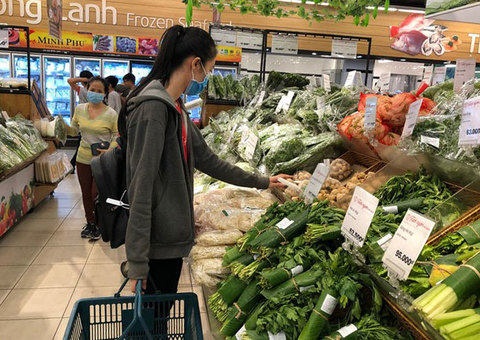Korea trade up 23% to $195M in Jan-Feb
Korea trade up 23% to $195M in Jan-Feb
Bilateral trade between Cambodia and South Korea reached $195.124 million in the first two months of 2022, a 22.762 per cent surge from $158.945 million in January-February 2021, according to data provided by the Korea International Trade Association (KITA) on March 21.
In January-February 2022, Cambodian exports to South Korea amounted to $64.554 million, down by 0.758 per cent year-on-year from $65.048 million, while imports clocked in at $130.570 million, rising by 39.056 per cent year-on-year from $93.897 million.
Cambodia’s trade deficit with South Korea over the period widened by 128.829 per cent to $66.015 million, from $28.849 million during the same time last year.
In February alone, Cambodian exports to South Korea amounted to $31.525 million, down by 2.546 per cent year-on-year from $32.349 million and 4.556 per cent month-on-month from $33.030 million.
Meanwhile, imports clocked in at $51.435 million, rising by 23.546 per cent year-on-year from $41.633 million, but dipping 35.002 per cent month-on-month from $79.134 million.
The Kingdom’s trade deficit with South Korea stood at $19.911 million in February, widening by 114.457 per cent year-on-year from $9.284 million, but narrowing by 56.814 per cent month-on-month from $46.105 million.
‘Lot of benefits’
Cambodia Chamber of Commerce (CCC) vice-president Lim Heng ascribed the overall rise in trade, especially in 2022, to strong bilateral political and trade cooperation as well as the large number of Cambodian migrant workers employed in South Korea.
He said that although Korean ventures in Cambodia are predominantly concentrated in real estate and construction, investment in agriculture areas is particularly tipped to grow at accelerated paces during the forthcoming period.
A bilateral Cambodia-Korea Free Trade Agreement (CKFTA) signed on October 26 is expected to enter effect no later than June 30, granting more than 10,000 Cambodian goods duty-free access to South Korea, according to Ministry of Commerce spokesman Penn Sovicheat.
Heng went on to say that having such trade deals “means that the movement of goods between partner countries will be easier and a number of tariffs will be removed”.
“Hence Cambodia, a labour-rich country, is able to leverage these agreements to reap in a lot of benefits,” he said.
According to Heng, major Cambodian exports to South Korea comprise garments, footwear, travel goods, beverages, electronic components, rubber, pharmaceuticals and agricultural products, while imports include vehicles, electronics, kitchen appliances, beverages and pharmaceuticals and plastics.
‘Positive momentum’
Hong Vanak, director of International Economics at the Royal Academy of Cambodia, noted that bilateral trade has remained on a steady growth trajectory in spite of the slew of challenges still hovering over the transport sector, and a global economy that remains below pre-Covid-19 levels.
He predicted that trade between the two countries would pick up, buoyed by the CKFTA and the Regional Comprehensive Economic Partnership (RCEP) agreement – which entered into force on January 1 in the Kingdom and exactly one month later in South Korea.
Under the CKFTA, coupled with the RCEP, Cambodia will lift tariffs on 93.8 per cent of goods traded, with South Korea scrapping duties on 95.6 per cent, Yonhap News Agency reported in October citing the South Korean trade ministry.
Vanak told The Post on March 21: “This positive momentum will continue, especially with the recent entry into force of the CKFTA, which will play an important role in allowing bilateral trade to gain a head of steam.”
When asked whether Cambodia’s trade deficit with South Korea was a cause of concern, Vanak responded that the CKFTA would stimulate Cambodian goods exports to the East Asian country, explaining that the “favourable conditions” of the deal would draw Korean and other foreign players to the Kingdom to produce merchandise for sale to the Korean market.
“I believe that the CKFTA will greatly shrink the aforementioned trade imbalance, and that’s because geographical factors, investment laws and a plentiful labour force will attract investors to invest in Cambodia soon, for more exports to the Korean market,” he said.
Commerce ministry spokesman Sovicheat previously told The Post that the CKFTA would create a pipeline of opportunities for agricultural and agro-industrial goods; finished textile-based products such as garments, footwear and travel bags; rubber; spare parts and electronic components; and light industrial products.
It will also facilitate the import of electronics, pharmaceuticals and auto parts, as well as raw materials, machinery and other equipment needed for industry, he said.
In 2021, Cambodia-South Korea trade totalled $965.364 million, up by 9.041 per cent from $885.322, according to adjusted Kita data retrieved on March 21.
Cambodian exports to South Korea amounted to $341.515 million, up by 7.357 per cent year-on-year from $318.112 million, while imports clocked in at $623.848 million, rising by 9.985 per cent from $567.210 million in 2020.
The Kingdom’s trade deficit with South Korea widened by 13.341 per cent from $249.099 million in 2020 to $282.332 million last year.














